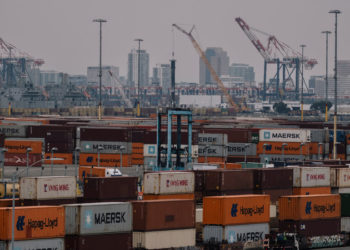The Supreme Court on Wednesday will start weighing the legality of tariffs that have raised costs on clothing and toys from China, cars and trucks from Canada and Mexico, liquor from Europe, and much more.
Yet even if the justices rule against the duties, implemented by President Donald Trump on a country-by-country basis, analysts argue there’s no guarantee that things will return to normal for consumers and businesses.
“The removal of [country-specific] tariffs would open the door for trade policy uncertainty to rise again,” analysts with Oxford Economics research group said in a note published Tuesday. That uncertainty, the note added, could end up delaying hiring and business investment — something that could further drag down an already-ailing labor market.
The tariffs are being challenged by five small businesses that believe Trump illegally used emergency powers to bypass Congress and impose the duties. The businesses, which include a wine importer, a pipe and fittings company, and a bicycle importing firm, allege they are facing significant financial burdens as a result of the tariffs.
“Genova Pipe is dependent on imports to continue its manufacturing operations,” attorneys for the businesses said in their suit, referring to the fittings firm. “The tariffs will directly increase the cost of raw materials, manufacturing equipment, and resale goods imported from abroad by Genova Pipe.”
Other businesses have also said tariffs are hurting them. On Monday, the Institute for Supply Management’s manufacturing index held in contraction territory for the eighth-straight month — with many respondents to its survey saying tariffs are weighing on their outlooks.
“Tariffs continue to be a large impact to our business,” an unidentified machinery firm said in the survey. “The products we import are not readily manufactured in the U.S., so attempts to reshore have been unsuccessful. Overall, prices on all products have gone up, some significantly.”
Yet there remains debate about the direct impact of the tariffs so far, many of which were enacted in August. Analysts with Bank of America found that prices for 101 commonly purchased items on Walmart.com had increased an average of roughly 3.4% between April and October — with toys in particular, many of which are made in China, seeing the biggest hit.
However, they said the effect on consumers has been less than what one would expect if the costs of tariffs were being fully passed through to consumers. Businesses, they said, seem to be absorbing significant levels of the costs.
In a statement to NBC News, the Yale Budget Lab, a policy think tank, likewise said that the effects of the tariffs “have been somewhat muted so far.”
Still, it added, tariffs are weighing on the economy in other ways.
“There’s no clear evidence that increased tariffs are responsible for the slowdown in job growth seen in recent months, although broader policy uncertainty is undoubtedly playing a role,” the lab said. “In general, we would expect to see the effects of tariffs to phase in over time as businesses modify their decisions to hire and/or invest.”
While large and small companies alike have been facing cost pressures from tariffs, smaller ones have likely taken an outsize hit. Bigger companies have more capital and resources to help them mitigate higher costs. Small businesses, though, were more likely to fall into a category of firms facing import tariff increases exceeding 25 percentage points, according to an August study by the Atlanta Federal Reserve.
“Small importers may be relatively more constrained in their ability to weather higher trade costs or switch suppliers, and, as a result, might experience defaults and bankruptcies,” the analysis found.
A ruling against the tariffs would likely lower the cost burden to businesses and consumers. But the economy could face turmoil if the court demands the administration refund tariff revenues. Country-specific duties totaled approximately $89 billion through August, according to government data.
In addition to the logistical challenge of sending refund checks to whoever paid the duties to U.S. officials, some analysts believe refunds could heat up economic activity — albeit with risks. A ruling against Trump may end up boosting consumer inflation pressures, Bank of America analysts said in a note published last week.
The Trump administration has already signaled it would attempt to use different legal authorities to reimpose the duties. Treasury Secretary Scott Bessent has suggested Trump would tap another statute, established in 1930, that would allow him to impose tariffs of up to 50% on countries that discriminate against U.S. commerce.
“You should assume that they’re here to stay,” Bessent said in an interview in September. The Oxford Economics analysts, meanwhile, have said they would be “unlikely to change our broader outlook for tariffs” even if the court decides against Trump.
Bessent said he plans to attend Wednesday’s arguments at the high court.
The post Supreme Court Trump tariff arguments: What’s at stake appeared first on NBC News.




